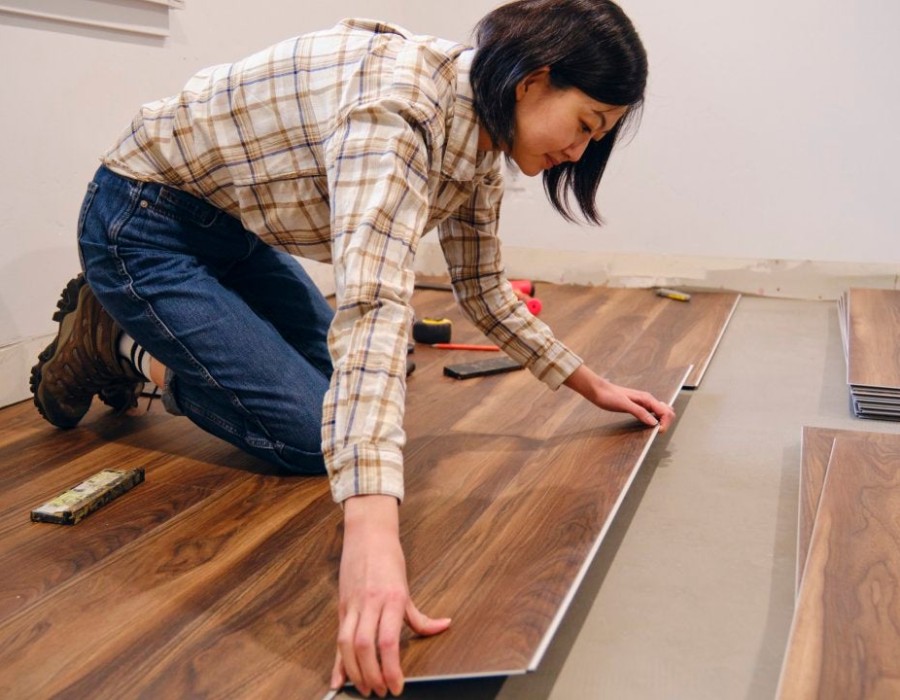Selecting the right flooring is key to defining a space's look and feel. Whether it's the elegance of hardwood, the practicality of tiles, or the comfort of carpet, your choice affects both maintenance and property value. The perfect flooring should fit your lifestyle, withstand daily wear, and complement your home's design, ensuring a welcoming and cohesive atmosphere.
Understanding Different Flooring Materials
Navigating the flooring options involves a comprehensive understanding of materials to make an informed decision. Here are a few options & things you should consider:
1. Hardwood:
- Timeless elegance
- Durable and long-lasting
- Adds value to the property
2. Laminate:
- Budget-friendly
- Resistant to scratches and stains
- Easy installation
3. Tile:
- Versatile design options
- Ideal for high-moisture areas
- Easy to clean and maintain
4. Carpet:
- Soft and comfortable underfoot
- Insulates against noise and temperature
- Broad range of styles and colors
5. Vinyl:
- Affordability with diverse styles
- Resilient and water-resistant
- Simple maintenance
6. Bamboo:
- Eco-friendly choice
- Unique and natural aesthetics
- Hard and durable surface
Understanding these materials empowers homeowners to align flooring choices with their preferences, lifestyle, and practical needs, ensuring a well-informed and satisfying selection.
Choosing Flooring That Fits You’re your Home & Finances
Selecting flooring that aligns with your budget involves carefully considering material costs, installation expenses, and long-term maintenance. Floating floor installation, which typically includes engineered hardwood, laminate, and luxury vinyl planks, is cost-effective. These floors "float" above the subfloor, reducing installation time and labor costs. Laminate floor installation is known for its affordability, making it an attractive choice for budget-conscious consumers.
Flooring that is tailored to your lifestyle is crucial for aesthetic satisfaction and practical functionality. If you have a busy household with pets and children, durable and easy-to-clean options like vinyl or tile may be ideal, as they withstand heavy traffic and resist stains.
Laminated Flooring:
A laminate floor installation becomes a standout choice when on a tight budget. It convincingly replicates the appearance of more expensive materials like hardwood or tile but at a fraction of the cost. Its click-and-lock design simplifies the installation process, minimizing installation fees. Additionally, laminate is often DIY-friendly, further saving on labor costs.
Vinyl Flooring:
Vinyl flooring is another budget-friendly option known for its resilience and low price point. Its versatility and water-resistant properties suit various spaces, including kitchens and bathrooms. Carpet, while offering comfort, tends to have a lower upfront cost but may require more maintenance over time.
Hardwood Flooring:
Consider the long-term financial implications as well. While hardwood floors might have a higher initial cost, their durability and ability to add value to your home can be a wise investment. Ultimately, by understanding the financial aspects of different flooring options, you can make an informed decision that suits your budget and aligns with your aesthetic preferences and lifestyle needs.
Carpets:
Carpets provide a cozy atmosphere for those seeking warmth and comfort in living spaces or bedrooms. If you prefer a sleek and modern look, consider the clean lines of hardwood or laminate. Homes in humid climates might benefit from moisture-resistant materials like tile or luxury vinyl.
Lifestyle considerations also extend to maintenance; high-maintenance materials like natural stone may not suit those with hectic schedules. By aligning flooring choices with your daily life, you not only enhance the longevity of the floors but also create a harmonious living environment that complements your unique lifestyle.
How to Ensure Your Floors Stands the Test of Time
Ensuring your flooring withstands the test of time involves strategic choices in materials, installation methods, and maintenance practices. Opting for durable materials like hardwood, tile, or engineered flooring sets a solid foundation.
Floating floor installation techniques, often employed with engineered hardwood or laminate, contribute to long-term stability. Not directly attached to the subfloor, these floors allow for natural expansion and contraction, reducing the risk of warping.
Regular maintenance, such as routine cleaning and addressing issues promptly, is essential. Use area rugs in high-traffic zones to minimize wear. Consider your household's lifestyle – if it's bustling with activity, choose scratch-resistant materials.
Conclusion
Investing in quality products and professional installation pays off in longevity. Hardwood floors can be refinished, extending their life. Adhering to manufacturer-recommended care instructions for each flooring type, including proper cleaning agents, safeguards against premature wear. By making informed choices and incorporating preventive measures, your flooring can endure the challenges of time, maintaining its aesthetic appeal and structural integrity.





Comments